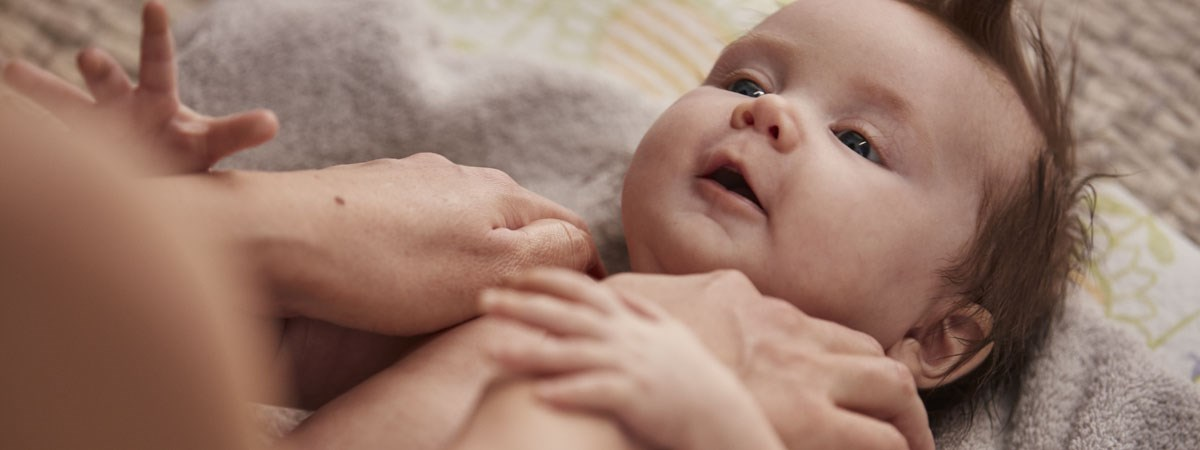Rashes and spots on children and babies

Attempting to identify red spots and itchy rashes on your child might become an unexpectedly big part of parenting. Read on to learn how to recognise various rashes on babies and young children, and possible causes.
Your baby’s skin is thinner than yours by half. That also means it’s more sensitive, and many little ones develop rashes during their first few years of life. It doesn’t take much for those spots to pop up and they can be caused by more or less anything – from hormones and eczema to heat, yeast and food. Some childhood illnesses cause rashes or so-called viral spots, which are infectious and often accompanied by a fever.
Because baby skin is so sensitive, your paediatrician will carefully monitor a rash, and together, you can discuss causes and treatments, like creams or salves.
Milia and hormonal spots in newborn babies
Even newborns get spots or rashes, most of which are completely harmless, not contagious, and don’t need to be treated. The most common are:
- Baby acne, which is actually called erythema toxicum, is a reaction to the baby’s new environment outside of the womb. These spots can have a yellow peak and look like tiny pimples. Breakouts may move around and the quantity will vary, ranging from just a few to quite a lot of spots. Hormonal spots disappear on their own after a while, once the baby is used to their new world.
- Milia are white, pin-sized sebum spots that usually appear on baby’s nose or cheeks. They usually disappear on their own after 1–2 months.
Heat rash is common in babies
Heat rash can arise easily, because babies have a harder time regulating their body temperature and may therefore develop a temporary rash caused by heat and moisture. The rash will appear mainly on baby’s little chest, bottom, legs, throat and armpits. It generally disappears as quickly as it came, and it’s completely harmless. A red and irritated baby bottom is usually caused by being too warm or moist.
Yeast can cause a red bottom
A yeast diaper rash will turn baby’s bottom shiny and red, and the baby will be in pain. You might see whitish scales gathering in the folds of the skin. The best way to prevent yeast diaper rash in infants is to frequently air out their skin folds, where moisture can easily be retained – so an extra moment on the changing table without a diaper covering their bottom is a good choice. You can also apply a bit of baby oil to reduce the risk of infection. A yeast diaper rash should be treated – so contact your paediatrician.
Atopic dermatitis – Flexural eczema
Atopic eczema is usually dry, red and itchy. Eczema on a baby can be heredity or due to the environment, and often appears already in the baby’s first year of life. Sometimes eczema is concentrated around the backs of the knees and creases of the arms and feet, and is therefore often called flexural eczema.
Hives are intensely itchy
Hives are usually very itchy, because histamine has been released, which produces powerful itchiness. Hives can be caused by a few different things, such as a food sensitivity, but can also be a reaction to a medication or cold air. Read more about hives in babies and what to pay attention to.
Impetigo
Impetigo is a skin infection that is usually caused by staphylococcus bacteria. Impetigo is most often seen in children, but adults are also susceptible. The rash usually begins with a red dot somewhere on the face which then forms a blister. More blisters usually form, especially on dry or raw skin. They develop a yellowish moist patch, and as long as the area is gooey or wet, the infection is contagious. It can be a little tricky to get rid of, but simple measures like proper hand hygiene and washing the area well usually work. A Google search will give you helpful information on how to clean impetigo.
Ringworm causes a scaly rash
The rash is caused by a fungal infection passed between people or via animals. Ringworm is a scaly rash that usually begins as a round, itchy area that grows in size and then forms a circular shape – hence the name. Ringworm usually appears on the arms, legs, chest, or face. There can be multiple breakouts on the body and as a rule, getting rid of it requires an antifungal medication. If you think your child has ringworm, you should contact your healthcare provider.
In our skin school, you can read up on how to take care of baby’s sensitive skin.
